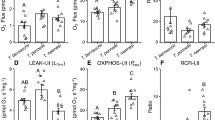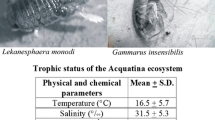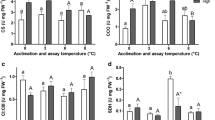Abstract
Antarctic fauna are highly adapted to the frigid waters of the Southern Ocean. This study describes the in vitro temperature sensitivity of oxygen consumption rates measured in liver mitochondria from the pelagic notothenioid Pleuragramma antarcticum between 5 and 35 °C. Oxygen fluxes were measured after the addition of millimolar levels of pyruvate, malate, succinate and glutamate (state II, LEAK) and saturating levels of ADP [state III, oxidative phosphorylation (OXPHOS)]. State III respiration significantly decreased above 18.7 °C. A comparison of the oxidative capacities among P. antarcticum and other notothenioids showed significant differences in state III respiration, where benthic species exhibited about 50 % lower rates than P. antarcticum. In addition, state III respiration rates normalized per milligram of mitochondrial protein of P. antarcticum were up to eight times higher than state III rates reported in the literature for other notothenioids. The comparatively high respiration rates measured in this study may be explained by our approach, which engaged both complexes I and II under conditions of oxidative phosphorylation. State III rates of independently activated complexes I and II were found to range from 42 to 100 % of rates obtained when both complexes were activated simultaneously in the same species. The remarkable tolerance of P. antarcticum OXPHOS toward warmer temperatures was unexpected for an Antarctic stenotherm and may indicate that thermal sensitivity of their mitochondria is not the driving force behind their stenothermy.





Similar content being viewed by others
References
Ballantyne J, Moon T (1986) Solute effects on mitochondria from an elasmobranch Raja erinacea and a teleost Pseudopleuronectes americanus. J Exp Zool 239:319–328
Bilyk KT, DeVries AL (2011) Heat tolerance and its plasticity in Antarctic fishes. Comp Biochem Physiol A: Mol Integr Physiol 158:382–390
Bilyk KT, Devries AL (2012) Heat tolerance of the secondarily temperate Antarctic notothenioid, Notothenia angustata. Antarct Sci 24:1–8
Bradford MM (1976) A rapid and sensitive method for the quantitation of microgram quantities of protein utilizing the principle of protein-dye binding. Anal Biochem 72:248–254
Cook DG, Iftikar FI, Baker DW, Hickey AJR, Herbert NA (2013) Low-O2 acclimation shifts the hypoxia avoidance behaviour of snapper Pagrus auratus with only subtle changes in aerobic and anaerobic function. J Exp Biol 216:369–378
DeVries AL (1983) Antifreeze peptides and glycopeptides in cold-water fishes. Annu Rev Physiol 45:245–260. doi:10.1146/annurev.ph.45.030183.001333
DeVries AL, Eastman JT (1978) Lipid sacs as a buoyancy adaptation in an Antarctic fish. Nature 271:352–353
Di Prisco G, Tamburrini M, D’Avino R (1998) Oxygen-transport systems in extreme environments: multiplicity and structure/function relationship in hemoglobins of Antarctic fish. In: Pörtner HO, Playle RC (eds) Cold ocean physiology. Cambridge University Press, Cambridge, pp 143–165
Eastman J (1993) Antarctic fish biology: evolution in a unique environment. Academic Press, San Diego, p 322
Eastman J, DeVries A (1989) Ultrastructure of the lipid sac wall in the Antarctic notothenioid fish Pleuragramma antarcticum. Polar Biol 9:333–335
Gnaiger E (2009) Capacity of oxidative phosphorylation in human skeletal muscle: new perspectives of mitochondrial physiology. Int J Biochem Cell Biol 41:1837–1845
Gnaiger E (2010a) Mitochondrial pathways through complexes I + II: convergent electron transfer at the Q-junction and additive effect of substrate combinations. pp 1–13 (MiPNet 12.12)
Gnaiger E (2010b) Mitochondrial pathways to complex I: respiration with pyruvate, glutamate and malate. pp 1–9 (MiPNet 11.04)
Hardewig I, Pörtner H, Peck L (1999a) Thermal sensitivity of mitochondrial function in the Antarctic Notothenioid Lepidonotothen nudifrons. J Comp Physiol B Biochem Syst Environ Physiol 169:597–604
Hardewig I, van Dijk PL, Moyes CD, Pörtner HO (1999b) Temperature-dependent expression of cytochrome-c oxidase in Antarctic and temperate fish. Am J Physiol Regul Integr Comp Physiol 277:R508–R516
Hazel J (1995) Thermal adaptation in biological membranes: is homeoviscous adaptation the explanation? Annu Rev Physiol 57:19–42
Hilton Z, Clements KD, Hickey AJR (2010) Temperature sensitivity of cardiac mitochondria in intertidal and subtidal triplefin fishes. J Comp Physiol B Biochem Syst Environ Physiol 180:979–990
Hochachka PW, Somero GN (1973) Strategies of biochemical adaptation. W. B. Saunders, Philadelphia
Hochachka PW, Somero GN (2002) Biochemical adaptation: mechanism and process in physiologica evolution. Oxford University Press, New York
Johnston I, Guderley H, Franklin C, Crockford T, Kamunde C (1994) Are mitochondria subject to evolutionary temperature adaptation? J Exp Biol 195:293–306
Johnston I, Calvo J, Guderley YH (1998) Latitudinal variation in the abundance and oxidative capacities of muscle mitochondria in perciform fishes. J Exp Biol 201:1–12
Lannig G, Storch D, Pörtner H (2005) Aerobic mitochondrial capacities in Antarctic and temperate eelpout (Zoarcidae) subjected to warm versus cold acclimation. Polar Biol 28:575–584
Lemieux H, Gnaiger E (2010) Oxygraph-2 k manual titrations: mitochondria, permeabilized cells, and biopsies. p 1 (MiPNet 09.12)
Mark FC, Lucassen M, Strobel A, Barrera-Oro E, Koschnick N, Zane L, Patarnello T, Pörtner HO, Papetti C (2012) Mitochondrial function in Antarctic Nototheniids with ND6 translocation. PLoS ONE 7:e31860
Middleton B (1978) Enzymatic aspects of ketone body metabolism: the role of mitochondrial acetoacetyl-CoA thiolase isoenzymes. In: Soling HD, Senfert C (eds) Biochemical and clinical aspects of ketone body metabolism. Georg Thieme Verlag, Stuttgart, pp 1–10
Moyes C, Buck L, Hochachka P, Suarez R (1989) Oxidative properties of carp red and white muscle. J Exp Biol 143:321–331
Moyes CD, Mathieu-Costello OA, Brill RW, Hochachka PW (1992) Mitochondrial metabolism of cardiac and skeletal muscles from a fast Katsuwonus pelamis and a slow Cyprinus carpio fish. Can J Zool 70:1246–1253
Nagel L, Plattner C, Budke C, Majer Z, DeVries AL, Berkemeier T, Koop T, Sewald N (2011) Synthesis and characterization of natural and modified antifreeze glycopeptides: glycosylated foldamers. Amino Acids 41:719–732
Nicholls DG, Ferguson SJ (2002) Bioenergetics. Academic Press, San Diego
Nickerson DM, Facey DE, Grossman GD (1989) Estimating physiological thresholds with continuous two-phase regression. Physiol Zool 62:866–887
O’Brien J, Dahlhoff E, Somero GN (1991) Thermal resistance of mitochondrial respiration: hydrophobic interactions of membrane proteins may limit thermal resistance. Physiol Zool 64:1509–1526
Saha A, Vavvas D, Kurowski T, Apazidis A, Witters L, Shafrir E, Ruderman N (1997) Malonyl-CoA regulation in skeletal muscle: its link to cell citrate and the glucose-fatty acid cycle. Am J Physiol Endocrinol Metab 272:E641–E648
Skulachev VP (1998) Uncoupling: new approaches to an old problem of bioenergetics. Biochim Biophys Acta 1363:100–124
Somero GN, DeVries AL (1967) Temperature tolerance of some Antarctic fishes. Science 156:257–258
Tamburrini M, D’avino R, Carratore V, Kunzmann A, Di Prisco G (1997) The hemoglobin system of Pleuragramma antarcticum: correlation of hematological and biochemical adaptations with life style. Comp Biochem Physiol A Physiol 118:1037
Torres J, Somero G (1988) Metabolism, enzymic activities and cold adaptation in Antarctic mesopelagic fishes. Mar Biol 98:169–180
Turner J, Colwell SR, Marshall GJ, Lachlan-Cope TA, Carleton AM, Jones PD, Lagun V, Reid PA, Iagovkina S (2005) Antarctic climate change during the last 50 years. Int J Climatol 25:279–294
Urschel MR, O’Brien KM (2009) Mitochondrial function in Antarctic notothenioid fishes that differ in the expression of oxygen-binding proteins. Polar Biol 32:1323–1330
Urschel M, O’Brien K (2008) High mitochondrial densities in the hearts of Antarctic icefishes are maintained by an increase in mitochondrial size rather than mitochondrial biogenesis. J Exp Biol 211:2638
Vaughan DG, Marshall GJ, Connolley WM, Parkinson C, Mulvaney R, Hodgson DA, King JC, Pudsey CJ, Turner J (2003) Recent rapid regional climate warming on the Antarctic Peninsula. Clim Change 60:243–274
Weinstein R, Somero G (1998) Effects of temperature on mitochondrial function in the Antarctic fish Trematomus bernacchii. J Comp Physiol B Biochem Syst Environ Physiol 168:190–196
Wohlschlag DE (1960) Metabolism of an Antarctic fish and the phenomenon of cold adaptation. Ecology 41:287–292
Acknowledgments
The authors of this manuscript would like to thank all crew members and members of the science party aboard the RV/IB Nathaniel B. Palmer (Cruise B-258-N) who assisted in the specimen collection. We would also like to thank Dr. Arthur L. DeVries for providing N. coriiceps specimens. This project was funded by NSF-0741348 awarded to Dr. Joseph J. Torres.
Author information
Authors and Affiliations
Corresponding authors
Additional information
Communicated by H.-O. Pörtner.
Eloy Martinez and Michael A. Menze contributed equally to this work.
Rights and permissions
About this article
Cite this article
Martinez, E., Menze, M.A. & Torres, J.J. Mitochondrial energetics of benthic and pelagic Antarctic teleosts. Mar Biol 160, 2813–2823 (2013). https://doi.org/10.1007/s00227-013-2273-x
Received:
Accepted:
Published:
Issue Date:
DOI: https://doi.org/10.1007/s00227-013-2273-x




